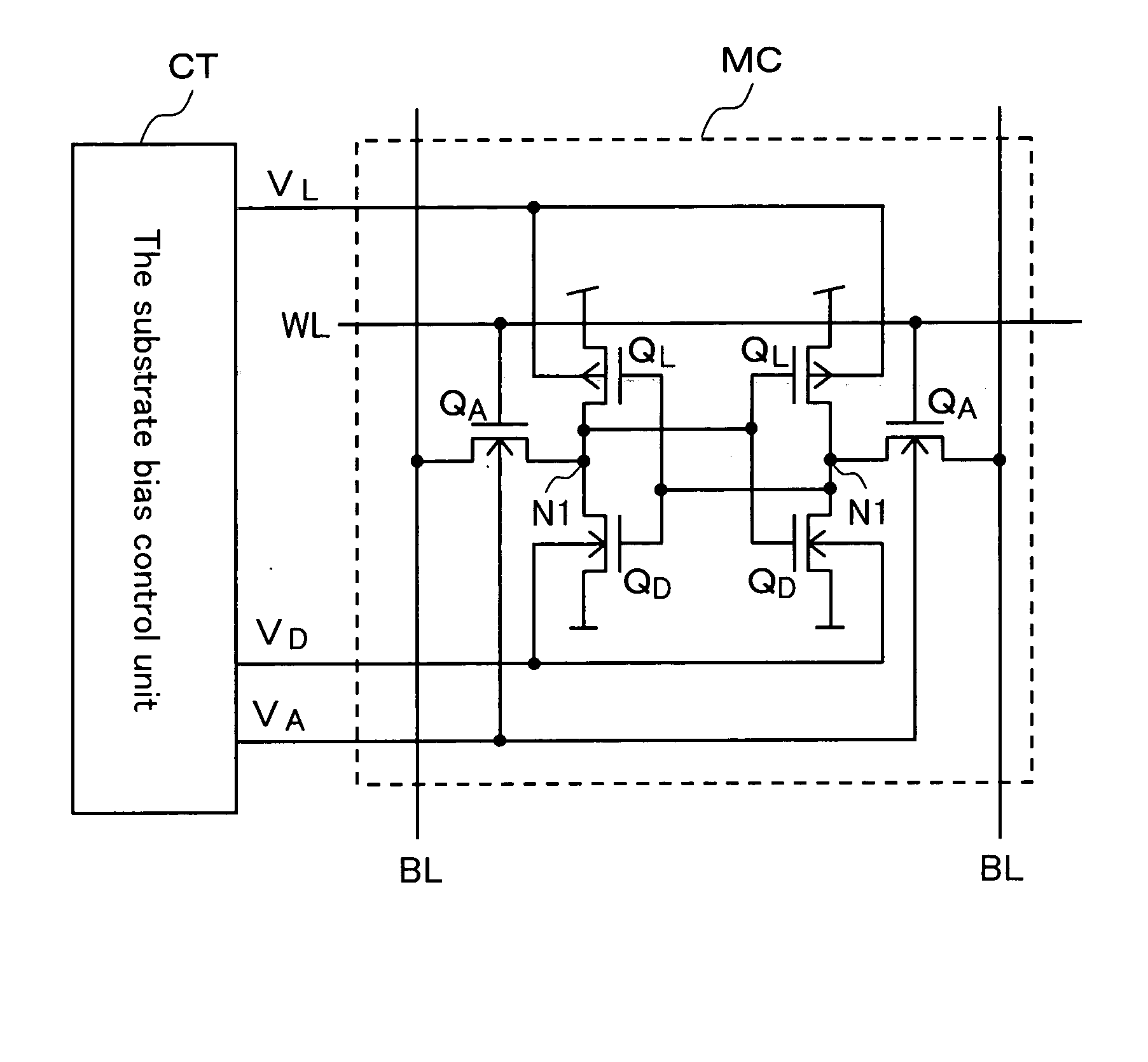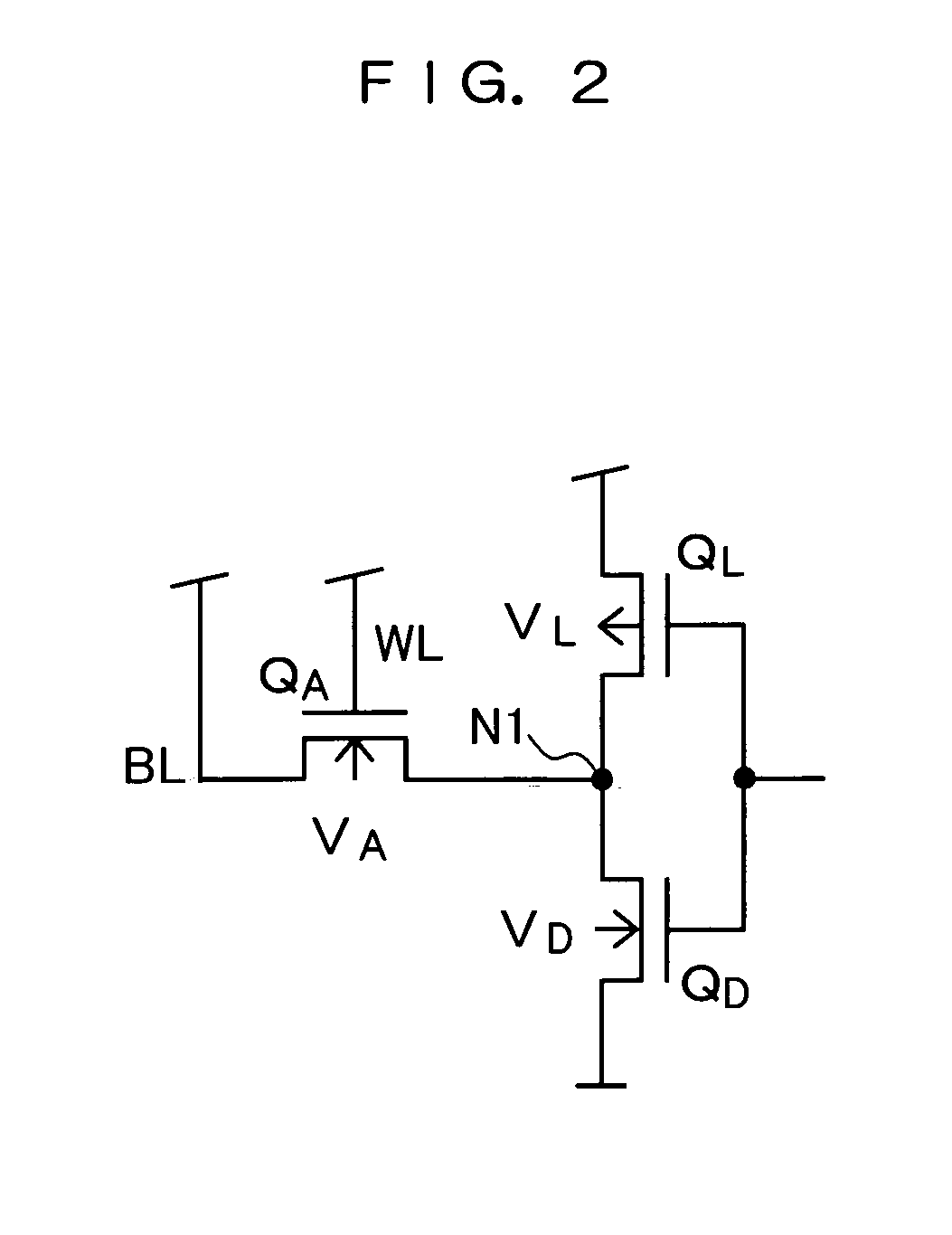Semiconductor memory
a technology of semiconductors and memory, applied in the field of semiconductor memory, can solve problems such as increased leak current, deterioration in reading-out speed, and increase in the amount of leak current, so as to improve the performance of cache access
- Summary
- Abstract
- Description
- Claims
- Application Information
AI Technical Summary
Benefits of technology
Problems solved by technology
Method used
Image
Examples
first embodiment
[0059] (First Embodiment)
[0060] As shown in FIG. 1, a semiconductor memory according to a first embodiment comprises a static-type memory cell MC and a substrate bias control unit CT for applying bias onto a transistor substrate of the memory cell MC.
[0061] The memory cell MC is configured with a pair of access transistors QA formed with NMOS transistors, a pair of drive transistors QD formed with NMOS transistors, and a pair of load transistors QL formed with PMOS transistors. The pair of load transistors QL and the pair of drive transistors QD form a memory storage. The junction point between the load transistor QL and the drive transistor QD is a memory storage node N1 to which the access transistors QA is connected.
[0062] The substrate bias control unit CT increases the access speed at the time of making access to the memory cell MC by adjusting electric current flown to the memory storage node N1 of the memory cell MC. In the meantime, it applies bias for improving the stabil...
second embodiment
[0088] (Second Embodiment)
[0089] A semiconductor memory according to a second embodiment of the present invention will be described by referring to FIG. 4. Shown in the illustration is an example of a SRAM memory cell array with four columns, four rows, and 1 bit output. In FIG. 4, reference numerals C1, C2, C3, C4 are the columns. Reference numerals W1, W2, W3, W4 are word lines being connected to the gates of the access transistor QA of each column. Reference numeral BL is a bit line being connected to the drains of the access transistors Q of each row. Reference numerals VLa1, VLa2, VLa3, VLa4 are the substrate potentials of the load transistors QL of each column, VDa1, VDa2, VDa3, VDa4 are the substrate potentials of the drive transistors QD of each column, and VAa1, VAa2, VAa3, VAa4 are the substrate potentials of the access transistors QA of each column. The same substrate potential is applied to the transistors of the memory cell in the same column. The substrate potential is...
third embodiment
[0096] (Third Embodiment)
[0097] A semiconductor according to a third embodiment of the present invention will be described by referring to FIG. 5. In FIG. 5, the same reference numerals as those of the second embodiment in FIG. 2 denote the same structural elements so that detailed description is omitted. Reference numerals L1, L2, L3, L4 are rows. Reference numerals VLb1, VLb2, VLb3, VLb4 are the substrate potentials of the load transistors QL, VDb1, VDb2, VDb3, VDb4 are the substrate potentials of the drive transistors QD, and VAb1, VAb2, VAb3, VAb4 are the substrate potentials of the access transistors QA. The same substrate potentials are applied to the transistors of the memory cell in the same column. The substrate potentials are separately applied to the transistors of the memory cell in different columns. Reference numerals CT21, CT22, CT23, CT24 are the substrate bias control units of each column.
[0098] With this configuration, it is possible to apply separate substrate po...
PUM
 Login to View More
Login to View More Abstract
Description
Claims
Application Information
 Login to View More
Login to View More - R&D
- Intellectual Property
- Life Sciences
- Materials
- Tech Scout
- Unparalleled Data Quality
- Higher Quality Content
- 60% Fewer Hallucinations
Browse by: Latest US Patents, China's latest patents, Technical Efficacy Thesaurus, Application Domain, Technology Topic, Popular Technical Reports.
© 2025 PatSnap. All rights reserved.Legal|Privacy policy|Modern Slavery Act Transparency Statement|Sitemap|About US| Contact US: help@patsnap.com



